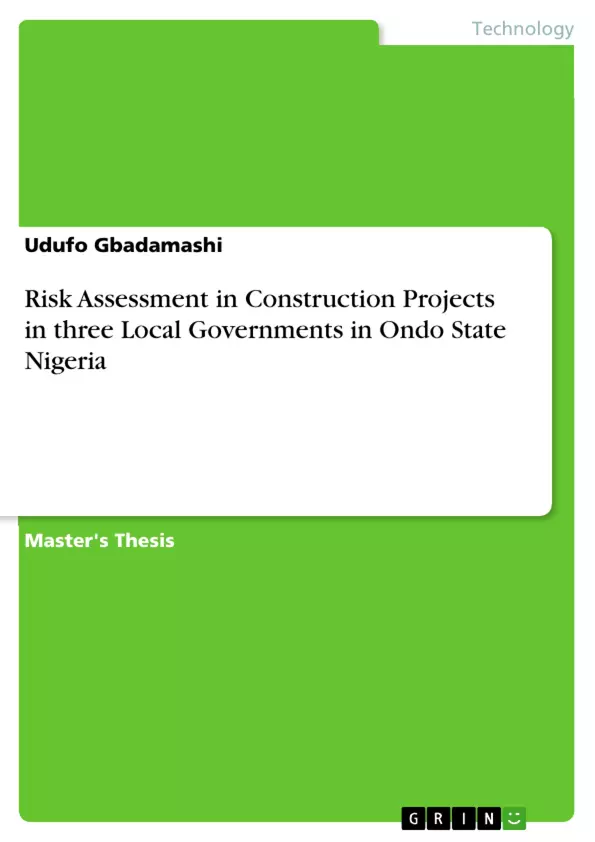The primary aim of this research study is to investigate, asses, identify and analyses various risk categories that are inherent in building and construction projects in three selected Local Governments - Ese-Odo and IIaje (riversides) and Okitipupa Local Governments in Ondo State. A comprehensive review and assessment of previous studies was used to draft a questionnaire for risk data collection. Out of the 16 contractors presently executing building projects in the three Local Governments and some selected Local Government staffs who were contacted as participants, only 12 contractors and some selected Local Government staffs agreed to participate in the stdy while 4 contractors declined to participate. Indeed, Seventy-seven (77) risk variables were identified under ten (10) risk factors in each questionnaire. However, seventy-two (72) questionnaires were randomly distributed to seventy-two (72) participants who constituted final sample for the study as respondents for their responses. These participants were grouped into 27 management employees which include: Director of Works (3), Civil Engineers (6), Director of Finance and Supplies (3), Project Managers (6) and Directors of Legal and Environmental (9) and 45 non-management employees which include: Contractors (12), Design team (Architects/Civil Engineers) (6), Consultants (Architects) (3), Construction team (Foremen) (12) and Sub-contractors (Transport owners) (12). The procedure of filling the questionnaire involves the selection of a set of attitude statements, to which respondents are asked to indicate their agreement or disagreement to each statement along a five-point Likert scale ranging from: “not-important (1), important (2), average (3), very important (4) to highly important (5)”. Respondents’ scores were tabulated by assigning a numerical value to each of the answers ranging from ‘1’ for the alternative at one end of scale to ‘5’for the alternative at the other. Accordingly, responses were analyzed using Microsoft Excel and Descriptive Statistics involving: Mean, standard deviations, variance, range (maximum and minimum) and respondents to determine the influence of all the identified risk variables in building and construction projects in the three selected Local Governments.
Inhaltsverzeichnis (Table of Contents)
-
CHAPTER ONE: INTRODUCTION
-
1.1 Background of the Study
-
1.2 Statement of the Problem
-
1.3 Objectives of the Study
-
1.4 Research Questions
-
1.5 Scope of the Study
-
1.6 Significance of the Study
-
1.7 Limitations of the Study
-
1.8 Definition of Terms
-
-
CHAPTER TWO: LITERATURE REVIEW
-
2.1 Introduction
-
2.2 Concept of Risk
-
2.3 Risk Assessment
-
2.4 Construction Projects
-
2.5 Factors Affecting Construction Risk Assessment
-
2.6 Risk Management
-
2.7 Previous Studies on Construction Risk Assessment in Nigeria
-
2.8 Summary of Literature Review
-
-
CHAPTER THREE: RESEARCH METHODOLOGY
-
3.1 Introduction
-
3.2 Research Design
-
3.3 Population of the Study
-
3.4 Sampling Techniques and Sample Size
-
3.5 Instruments for Data Collection
-
3.6 Methods of Data Collection
-
3.7 Methods of Data Analysis
-
-
CHAPTER FOUR: DATA PRESENTATION AND ANALYSIS
-
4.1 Introduction
-
4.2 Demographic Data
-
4.3 Presentation and Analysis of Data
-
-
CHAPTER FIVE: SUMMARY, CONCLUSION AND RECOMMENDATION
Zielsetzung und Themenschwerpunkte (Objectives and Key Themes)
This research study aims to comprehensively investigate, assess, and analyze various risk categories inherent in building and construction projects in three selected Local Governments in Ondo State: Ese-Odo, Ilaje (riverside areas), and Okitipupa. The research utilizes a comprehensive review of previous studies and a questionnaire for data collection. The primary objective is to understand the influence of identified risk variables on construction projects in these Local Governments.
-
Risk Assessment in Construction Projects
-
Influence of Risk Factors on Building and Construction Projects
-
Identification and Analysis of Risk Categories in Three Local Governments
-
Recommendations for Risk Management in Construction Projects
-
Impact of Local Government Context on Construction Risk
Zusammenfassung der Kapitel (Chapter Summaries)
Chapter One introduces the research context, outlining the background of the study, problem statement, objectives, research questions, scope, significance, limitations, and definition of key terms. Chapter Two presents a comprehensive literature review, exploring the concept of risk, risk assessment, construction projects, factors affecting construction risk assessment, risk management, and previous studies on construction risk assessment in Nigeria. Chapter Three delves into the research methodology, outlining the research design, population, sampling techniques, instruments for data collection, methods of data collection, and methods of data analysis. Chapter Four presents the demographic data and the detailed analysis of the collected data, showcasing the influence of various risk variables on building and construction projects in the three selected Local Governments.
Schlüsselwörter (Keywords)
Construction Risk, Risk Assessment, Building Projects, Local Governments, Ondo State, Risk Factors, Risk Management, Questionnaire Survey, Data Analysis, Descriptive Statistics, Building Codes, Safety Regulations, Environmental Impacts, Construction Costs, Project Management, Legal Issues, Contractual Agreements, Financial Planning.
- Arbeit zitieren
- B.SC Udufo Gbadamashi (Autor:in), 2019, Risk Assessment in Construction Projects in three Local Governments in Ondo State Nigeria, München, GRIN Verlag, https://www.grin.com/document/469730



